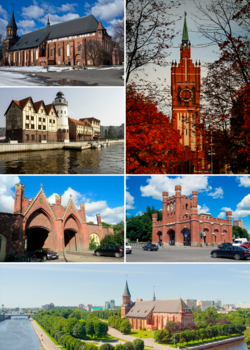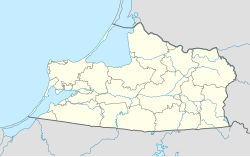Kaliningrad, Russia
| Kaliningrad (in English) Калининград (Russian) |
|
|---|---|
| - City - | |
 Church of the Holy Family; Königsberg Cathedral; "Fishermen's village" in pseudo-historic style; Brandenburg Gate; King's Gate; Pregolya River |
|
 Location of Kaliningrad Oblast in Russia |
|
|
|
|
|
|
|
|
|
|
| Anthem | none |
| City Day | July 4; observed on the first Saturday of July |
| Administrative status (as of November 2011) | |
| Country | Russia |
| Federal subject | Kaliningrad Oblast |
| Administratively subordinated to | city of oblast significance of Kaliningrad |
| Administrative center of | Kaliningrad Oblast, city of oblast significance of Kaliningrad |
| Municipal status (as of July 2009) | |
| Urban okrug | Kaliningrad Urban Okrug |
| Administrative center of | Kaliningrad Urban Okrug |
| Head | Alexander Yaroshuk |
| Representative body | City Council of Deputies |
| Statistics | |
| Area (February 2013) | 223.03 km2 (86.11 sq mi) |
| Population (2010 Census) | 431,402 inhabitants |
| - Rank in 2010 | 40th |
| Population (January 2014 est.) | 448,548 inhabitants |
| Density (February 2013) | 1,900/km2 (4,900/sq mi) |
| Time zone | USZ1 (UTC+02:00) |
| Founded | September 1, 1255 |
| Previous names | Königsberg (Kyonigsberg) (until 1946) |
| Postal code(s) | 236001, 236003–236011, 236013–236017, 236019–236024, 236028, 236029, 236034–236036, 236038–236041, 236043, 236044, 236700, 236880, 236885, 236890, 236899, 236931, 236950, 236960–236962, 236967, 236970, 236980–236983, 236985, 236989, 236999 |
| Dialing code(s) | +7 4012 |
|
|
|
| on | |
Kaliningrad (Russian: Калининград; IPA: [kəlʲɪnʲɪnˈgrat]) (former German name: Königsberg; Russian: Кёнигсберг, tr. Kyonigsberg; Old Prussian: Twangste, Kunnegsgarbs, Knigsberg; Polish: Królewiec; Lithuanian: Karaliaučius) is the administrative center of Kaliningrad Oblast, a Russian semi-exclave between Poland and Lithuania on the Baltic Sea.
In the Middle Ages, it was the site of Old Prussian settlement Twangste. In 1255, during the Northern Crusades, a new fortress was built by the Teutonic Knights. The city became the capital of the Duchy of Prussia and East Prussia (part of Germany). It was heavily damaged during World War II and its population fled or was removed by force when it became a Russian city. According to the 2010 Census, its population was 431,902.
...
Wikipedia



